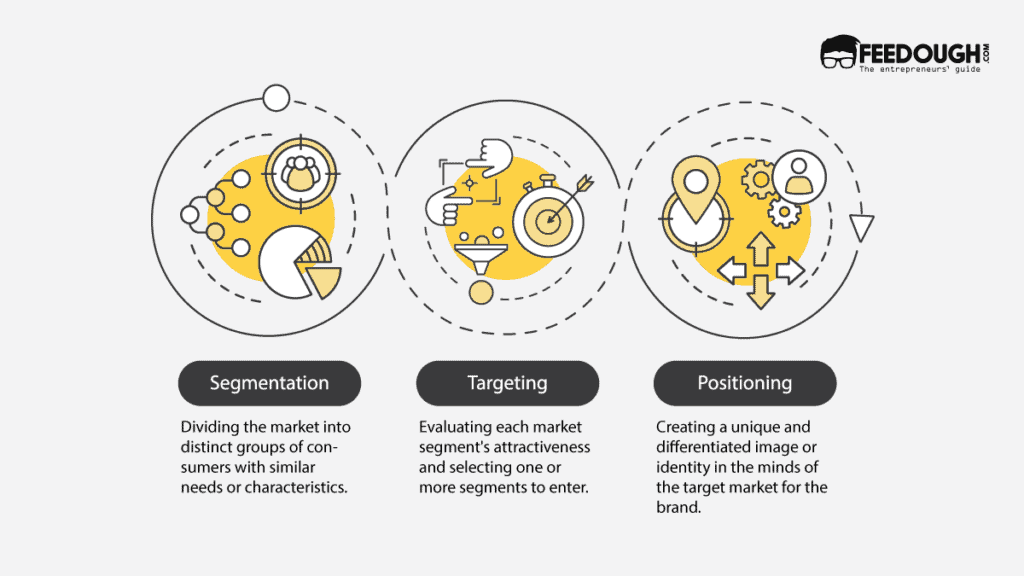Today, several businesses make the mistake of commencing their marketing without a plan or target audience in mind. As a result, they waste time and money on activities that do not lead to conversions.
It is vital for any business first to segment their target market and then craft a strategy to target them. The Segmentation, Targeting, and Positioning (STP) model is a powerful tool that helps marketers achieve these objectives.
This STP marketing model focuses on commercial effectiveness by identifying the most valuable segments for a company’s marketing mix and product positioning strategy. Without it, marketing programmes would be generic, lack personalisation, and fail to convert at a level that most firms consider adequate.
But what is STP marketing model? How does it work? What are its advantages and disadvantages? This article will answer all these questions.
What Is STP Marketing Model?
The STP marketing model, short for Segmentation, Targeting, and Positioning model, is a marketing framework that helps businesses identify relevant market segments, target these segments with the right marketing mix, and position their products and services to create a distinct image in the minds of consumers.
This marketing approach has been around for decades and is still used by firms today because it is an effective way to ensure that marketing programmes are relevant to the target audience, differentiated from the competition, and have a clear focus.
How Does STP Model Work?

The STP model is a tool that helps businesses segment the market, target specific segments with tailored offerings, and create a positioning strategy that showcases their unique value proposition.
There are three steps involved in the STP marketing process:
Segmentation
Market segmentation refers to the process of dividing the market into distinct groups of consumers with similar needs or characteristics.
It aims to identify target markets that can be reached with tailored messages that resonate with them.
There are several ways to segment a market, but the most common methods include:
- Geographic segmentation: dividing the market by region, country, city, or even neighbourhood.
- Demographic segmentation: dividing the market by age, gender, income, occupation, education, religion, or family life cycle.
- Psychographic segmentation: dividing the market by personality traits, values, attitudes, interests, or lifestyles.
- Behavioural segmentation: dividing the market by consumer knowledge, attitude, use, or response to a product.
Instead of trying to appeal to the entire market with one marketing mix, the STP marketing model helps businesses segment their markets into several groups that can be later targeted with separate marketing strategies.
Take a gaming mobile phone manufacturer company, for example.
The company could use demographic segmentation to target its products at male and female customers within a certain age range. It can also segment its market by customer age demographics – school, college, and office goers.
It could then use psychographic segmentation to identify power users, casual gamers, social gamers and non-gamers.
Finally, it could use behavioural segmentation to target customers who frequently play mobile phone games.
Targeting
Targeting is the process of evaluating each market segment’s attractiveness and selecting one or more segments to enter.
Businesses following the STP model select segments based on their potential to grow and generate high profits at low costs.
Some of the factors for targeting a segment are:
- Profitability: The chosen segment should be profitable, which means that the customers in the segment should be willing to buy your products and services.
- Size and scalability: The chosen market segment should have the potential for sustained growth.
- Accessibility: The segment should also be accessible or reachable for sales and marketing messages.
For example, the gaming mobile phone company can evaluate its segmented market and target budget-conscious college-going students who are the core audience for gaming mobile phones.
Positioning
Positioning is the process of creating a unique and differentiated image or identity in the minds of the target market for the brand (brand positioning) or product (product positioning).
In simple terms, positioning makes customers view a specific brand in a unique way by associating emotions, traits, feelings, and sentiments with it. These associations make the brand unique and different from its competitors.
There are three common approaches to positioning:
- Symbolic positioning: Positioning based on the customer’s image, identity or lifestyle.
- Functional positioning: Positioning based on the benefits of your product or the value it provides to the customer.
- Experimental positioning: Positioning focussing on the customers’ experience and emotional connection with your product.
Gaming phone Asus ROG Phone 6 positions itself as a “serious” phone for gamers. The brand positions itself as a durable gaming phone with a long-lasting battery and is equipped with the latest features to provide customers with the best gaming experience. This positioning helps customers understand what the phone has to offer and why it is different from other smartphones in the market.

The Importance Of STP Marketing Model
The STP model is important because it helps businesses find a way to identify the right target market and reach the same through a strategic process. This model can also help businesses understand their customers better, find out what they want, and develop a personalised customer experience for their target segment.
Besides this, here’s how it helps businesses:
- Helps find the most profitable segment: The STP process helps businesses find the most profitable target market segment out of all the potential segments. This is because businesses can identify the needs and wants of each segment and then design their products or services to match those needs.
- Helps develop right product for the right audience: The STP marketing process helps businesses to identify the right product for the right audience. It also allows businesses to better understand their target audience and create products they need and want.
- Leads to better positioning: This process results in the right positioning of products in the market. This is because businesses can identify the right target audience and understand their needs and wants, which helps them position their products accordingly.
- Helps develop an optimal marketing mix: The STP process helps businesses develop an optimal product, place, price, and promotion mix based on their target audience’s needs and wants.
Advantages Of STP Marketing
There are several advantages of STP marketing which are as follows:
- Increases sales and profit: Businesses following the STP model are more likely to see an increase in sales and revenue. This is because they have a better understanding of their target audience and know how to reach them.
- Improves customer satisfaction: The STP model leads to improved customer satisfaction as businesses are able to provide their target audience with products and services that they need and want.
- Improves decision making: The STP process helps businesses make better marketing decisions as it provides them with a clear understanding of their target audience.
- Results in better decision making: The STP process helps businesses make better decisions according to the needs of their target audience.
- Results in better ROI of marketing campaigns: The STP process leads to improved return on investment of marketing campaigns as businesses are able to allocate their resources more efficiently –
- Avoids wastage: The STP process helps businesses avoid wastages, as they know exactly who their target audience is and how to reach them.
Disadvantage Of STP Marketing
While there are many advantages of STP marketing, there are some disadvantages as well which are as follows:
- Time consuming: The STP process can be quite time-consuming as it involves a lot of research and data analysis.
- Requires expertise: The STP marketing process requires individuals with expertise in marketing and market research to be able to carry it out effectively.
- Costly: The STP process can also be quite expensive as it requires businesses to invest in market research and data analysis.
STP Marketing Model Examples
The STP marketing model can be best explained with the help of examples. Let us take a look at some examples to understand this concept better.
Nike
Nike is one of the world’s most popular sports brands. The company uses the STP marketing model to reach its target market of athletes and sports enthusiasts.
- Segmentation: Nike segments the market by sport, age, gender, and lifestyle.
- Targeting: It targets two segments – professional athletes and sporty individuals.
- Positioning: Nike positions itself as a sports brand that understands the needs of athletes and sports enthusiasts by providing high-quality and innovative products. It portrays the same using its brand-mark ‘The Swoosh’ and slogan ‘Just Do It.
McDonald’s
McDonald’s is one of the largest fast-food chains in the world. The company uses the STP marketing model to reach its target market of families and children that are looking for a quick and affordable meal.
- Segmentation: McDonald’s segments the market by age, income, gender, lifestyle, and location.
- Targeting: It targets families and children that are looking for a quick and affordable meal.
- Positioning: McDonald’s positions itself as a fast-food restaurant perfect for families on the go. It uses its ‘Happy Meal’ to appeal to children and its various promotions to appeal to families looking for a deal.
iPhone
The iPhone was launched in 2007 and quickly became one of the most popular smartphones on the market. Apple used the STP marketing model to successfully market the iPhone to its target audience.
- Segmentation: Apple segmented the smartphone market by income, lifestyle, and age.
- Targeting: The brand decided to target affluent consumers who were looking for a sophisticated and stylish smartphone.
- Positioning: It positioned the iPhone as a premium smartphone owned by successful and fashionable people. It also positioned the iPhone as a status symbol.
Bottom-Line?
The STP marketing model is a powerful tool that businesses can use to find the right audience, craft the perfect marketing campaign, and boost sales. When used correctly, the STP marketing model can help businesses to increase brand awareness, build customer loyalty, and generate more sales. However, it is important to remember that the STP marketing model is just one tool in a marketer’s toolbox. There are other marketing strategies and models that businesses can use to achieve their desired results.
Go On, Tell Us What You Think!
Did we miss something? Come on! Tell us what you think about our article on STP marketing model in the comments section.
A startup consultant, digital marketer, traveller, and philomath. Aashish has worked with over 20 startups and successfully helped them ideate, raise money, and succeed. When not working, he can be found hiking, camping, and stargazing.





![What Is Demand Generation? [The Ultimate Guide] What Is Demand Generation?](https://www.feedough.com/wp-content/uploads/2019/05/DEMAND-GENERATION.webp)
![Go-To-Market Strategy [The Ultimate Guide] go-to-market strategy](https://www.feedough.com/wp-content/uploads/2019/10/go-to-market-strategy.webp)


